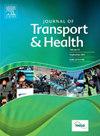How do bike-sharing usage patterns evolve before and after the pandemic? Evidence from the city of chicago
IF 3.2
3区 工程技术
Q2 PUBLIC, ENVIRONMENTAL & OCCUPATIONAL HEALTH
引用次数: 0
Abstract
The COVID-19 pandemic significantly altered travel behaviors, leading to notable evolutions in bike-sharing usage patterns. With limited explorations of post-pandemic patterns in existing literature, this study addresses two questions: (1) What are the spatiotemporal features of bike-sharing ridership before and after the COVID-19 pandemic? (2) What factors influenced bike-sharing travel behaviors during these periods? To answer the first question, we analyze bike-sharing trip data in Chicago from 2018 to 2023 (spanning pre-, during, and post-pandemic), to provide descriptive analysis of the overall, temporal, and spatial shifts in bike-sharing usage. For the second question, by integrating bike-sharing trip data with socio-demographics, land use, bike-sharing docks, and COVID-19 cases at the block group level, we employ Gradient Boosting Decision Tree (GBDT) models combined with SHapley Additive exPlanations (SHAP) to quantify the importance of these factors, along with their nuanced effects across samples. Findings reveal that, firstly, post-pandemic bike-sharing patterns grew on weekday evenings and weekend afternoons, and bike-sharing docks and bike-sharing usage were expanded to the surrounding neighborhoods. Secondly, White/Asian proportion, labor force, income and commercial land at the census block group level are critical influencing factors on bike-sharing usage, among which the number of docks is the most influential one. Notably, thresholds for the key factors are observed across the three periods, below which the positive and negative effects on bike-sharing usage vary among samples. Once exceeding the thresholds their impacts are commonly positive, which indicates the scale effects of these factors. The positive impacts of these factors on bike-sharing usage increased post-pandemic compared to those pre- and during-pandemic. These findings together demonstrate increased commercial and recreational use of bike-sharing and identify frequent bike-sharing user groups including the White and Asian populations in Chicago, which provide empirical evidence for bike-sharing facility planning and service operations.
疫情前后共享单车的使用模式有何变化?证据来自芝加哥市
新冠肺炎疫情显著改变了人们的出行行为,导致共享单车的使用模式发生了显著变化。鉴于现有文献对大流行后模式的探索有限,本研究解决了两个问题:(1)新冠肺炎大流行前后共享单车出行的时空特征是什么?(2)这些时期影响共享单车出行行为的因素是什么?为了回答第一个问题,我们分析了2018年至2023年芝加哥的共享单车出行数据(跨越疫情前、期间和后),对共享单车使用的总体、时间和空间变化进行了描述性分析。对于第二个问题,通过将共享单车出行数据与社会人口统计学、土地使用、共享单车码头和区块组层面的COVID-19病例相结合,我们采用梯度增强决策树(GBDT)模型结合SHapley加性解释(SHAP)来量化这些因素的重要性,以及它们在样本间的细微影响。结果表明:第一,疫情后共享单车模式在工作日晚上和周末下午有所增加,共享单车码头和共享单车使用范围扩大到周边社区。其次,人口普查区白人/亚裔比例、劳动力、收入和商业用地是影响共享单车使用的关键因素,其中码头数量是影响最大的因素。值得注意的是,关键因素的阈值是在三个时期观察到的,低于阈值,对共享单车使用的正面和负面影响在样本中有所不同。一旦超过阈值,它们的影响通常是积极的,这表明这些因素的规模效应。与大流行前和大流行期间相比,这些因素对共享单车使用的积极影响在大流行后有所增加。这些发现共同证明了共享单车的商业和娱乐用途的增加,并确定了包括芝加哥白人和亚洲人口在内的频繁共享单车用户群体,这为共享单车设施的规划和服务运营提供了经验证据。
本文章由计算机程序翻译,如有差异,请以英文原文为准。
求助全文
约1分钟内获得全文
求助全文

 求助内容:
求助内容: 应助结果提醒方式:
应助结果提醒方式:


